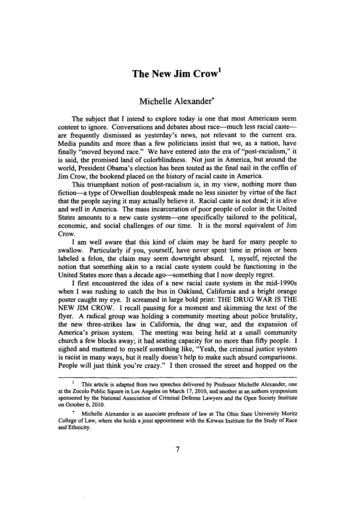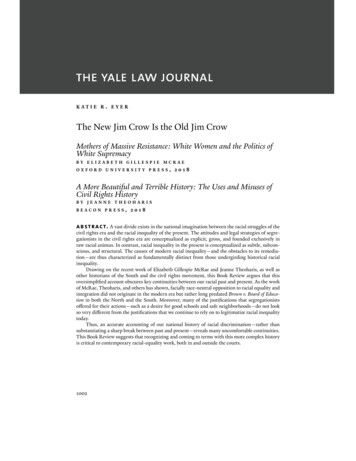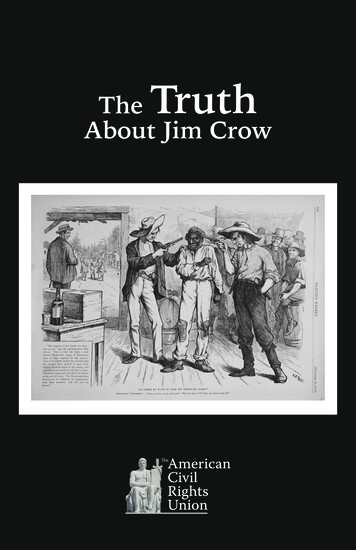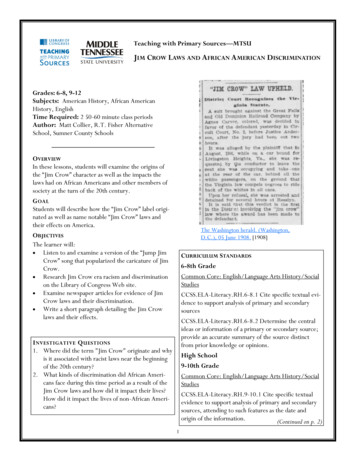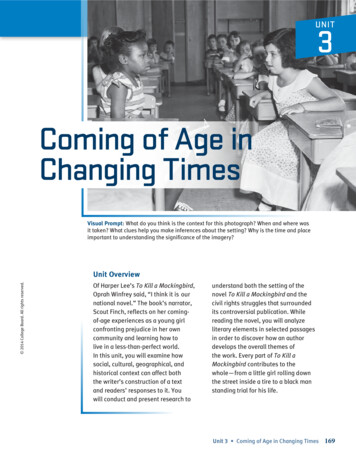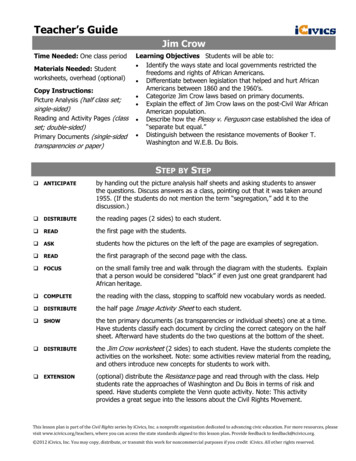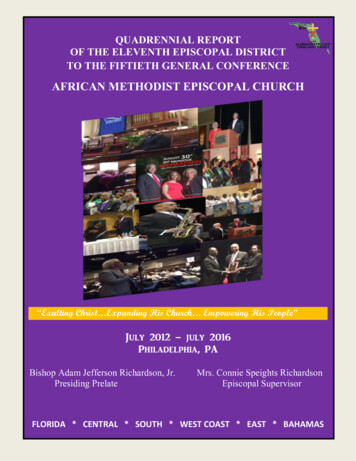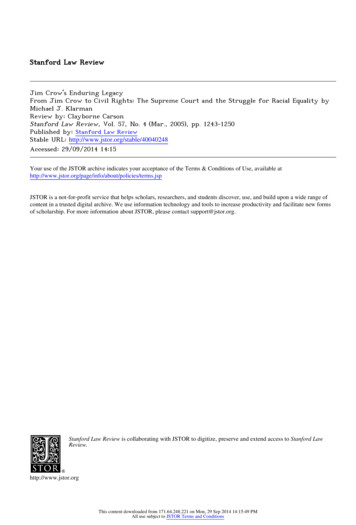
Transcription
The New Jim CrowbyMichelle AlexanderResource Guide for Adult FormationSix-week reading and reflection group about massincarceration, racism, and the War on DrugsAuthored, Compiled, Edited by:Episcopal Diocese of CaliforniaUrban Peace Collaboration
Table of ContentsNOTE FROM THE EDITOR AND HOW TO USE THIS GUIDE:3GETTING A GROUP TOGETHER5AGENDA AND STRUCTURE8OPENING AND CLOSING PRAYER9MAKING AND REVIEWING A GROUP COVENANT13SMALL GROUPS15DEMOGRAPHICS IN THE READING GROUP16SESSION 1: INTRODUCTION AND THE REBIRTH OF CASTE17SESSION 2: THE LOCKDOWN19SESSION 3: THE COLOR OF JUSTICE21SESSION 4: THE CRUEL HAND23SESSION 5: THE NEW JIM CROW25SESSION 6: THE FIRE NEXT TIME27NEXT STEPS292
Note from the Editor and How to Use this Guide:The New Jim Crow: Mass Incarceration in the Age of Colorblindness was writtenby Michelle Alexander, a civil rights litigator and professor of law, and published in2010. The book argues that our current system of mass incarceration in the United Statesis unprecedented, disproportionately incarcerates black men at extremely high rates, andhas thus has come to replace the Jim Crow segregation laws as our current form of massracial control. To show how mass incarceration functions as a system of racial control,Alexander demonstrates how the War on Drugs functions in such a way that at all levelsof the criminal justice system, people of color are unjustly treated and swept into theprison system, branded as felons for mainly nonviolent crimes, and are subjected tomassive institutional discrimination for the rest of their lives. Most importantly, perhaps,Alexander shows how our dominant definition of “racism” as personal prejudice, insteadof the concrete effects of institutional systems, such as the criminal justice system, thatsubject people of color to human rights violations, allow us to remain complicit in a racistsociety that purports to be “colorblind,” since it’s not blackness that is explicitly targetedbut criminality.Cornel West has called the book “secular bible for a new social movement inearly twenty-first-century America.” Although, as Alexander clearly states in herintroduction, her book is mainly a critique of our current system, and does not pretend tohave a solution, The New Jim Crow has been regarded by many as a call to action. It is atransformative read that for many people who do not have direct experiences with orwithin the criminal justice system, and is a wake-up call to the fact that racism is aliveand well in the United States on a massive institutional level.In August of 2014, Michael Brown, an unarmed, young black man, was shot andkilled by Darren Wilson, a white police officer, in Ferguson, Missouri. In response to hisdeath, local and national networks of organizers sprung into action to call nationalmainstream attention to the regularity and systematic devaluing of the lives of people ofcolor. Every 28 hours, a black person is killed by law enforcement or vigilante, which iscomparable to rates of Jim Crow-era lynching. According to a report from the SentencingProject in 2013, if current trends of incarceration continue, 1 in 3 African Americanmales can expect to go to prison at some point in their lifetime. Arguably, we are findingourselves in a time of social change, which inevitably entails wrestling with the surfacingof certain realities about race and racism that may feel uncomfortable. We are findingourselves in a time when individuals and communities are searching for ways to haveconstructive conversations about these difficult events and topics.Rev. Sylvia Miller-Mutia, Associate Rector at St. Gregory’s of Nyssa in SanFrancisco, and I worked together to see how much interest there was around starting up abook group about racism and mass incarceration. We ended up, with the help of otherleaders connected to our communities, helping organize 5 book groups—one in3
Richmond, two in San Francisco, and one in Berkeley, all with significant interest. Sylviaand I co-facilitated the group in Berkeley, and ran the reading & reflection group as aformation opportunity during Epiphany in January and February of 2015. It was our firsttime facilitating a reading group for The New Jim Crow.After the conclusion of the group, we decided we wanted to offer the structure,questions, and materials we used as a resource for other Episcopal congregations in theDiocese of California that are seeking to have guided conversations about racism in theUnited States during this time of social change. We feel that it is an important formationresource to have for congregations grappling with these issues, and valuable way to buildcommunity within and between congregations. Education is the first step to action, andfinding ways for individuals and congregations to remain committed to fighting racism intheir local communities and in the United States at large. One important note thisfacilitation guide is built for someone who has close to no experience organizing orrunning an adult formation class or book group —you do not necessarily need a trainedfacilitator to do this. It would obviously be helpful if a trained facilitator was alreadyavailable to help lead, but this guide will provide helpful tips for facilitators new to theirrole about group facilitation, including things we did that worked, things we did thatmaybe didn’t work.If you use this guide, please feel free to reach out to us and let us know how it’sgoing. Let us know how we can be helpful or if we can answer any questions you mayhave. Thank you for your interest and your commitment to finding ways to talk aboutthese difficult topics.In Peace,Em Kianka,Urban Peace Collaboration4
Getting a Group TogetherIf you’re reading this guide, you may already have a group together at your congregationthat would like to read The New Jim Crow. If you do, this section will not be helpful foryou. If you would like to get a group together, however, then we have outlined two mainoptions and some strategies for you to help organize a group at your church.1. Picking a Time and a SeasonYou may want to plan to organize the group’s six-week course so that itthematically fits in with the Episcopal Church’s liturgical calendar. When Sylviaand I organized these groups, Sylvia structured the course so that it coincided andwas also thematically tied to Epiphany. The reflection group would also be a veryappropriate Lenten study, for example. You can also feel free to organize thegroup after Easter, or run a summer group, when perhaps other activities may beslow, and there is a call for more programming, or a fall group, when people arereturning from summer trips or vacations and are getting back into the swing ofthings.2. Forming a Congregational GroupThere are some significant benefits to organizing a group of people who are allmembers of the same church, and already have relationships with each other.Talking about racism and the War on Drugs can be an intense and sensitivesubject for many people, and forming a group of people who already know eachother may increase openness in discussion. Also, if you are a priest, or if yourpriest can be available to be present in the group, you or they may be available forpastoral support in case difficult conversations arise.Forming a group in your own congregation may be really easy, or may provedifficult. Asking people to commit to a six-week discussion group can be a bigcommitment for many people. If you are starting this on your own, talk to yourfriends at church first. Talk with the members of the outreach or social justicegroup, if there is one. Make announcements in the bulletin or church newsletter.Tell people why this is important to do. Even if you form a group of four, that isgreat, and will be enough. Be grateful for whatever number of folks are in thegroup you organize.3. Forming an Inter-Congregational or Interfaith GroupWhile there are benefits to a reading group wherein everyone already knows eachother, there are also significant advantages to a group where not everyone knowseach other. If you want to create an open community group, and invite friends andpeople from other congregations in the area, you can create a space where perhapspeople are coming from various contexts—not only different congregations, butperhaps a diversity of cities or neighborhoods, with differing understandings and5
experiences of the issues Alexander presents in the book. This would widen thespectrum of people present in the room, and foster a diversity of opinion andexperience in conversation. It would also build community in such a way thatreaches beyond congregational lines, and maybe even result in some kind ofofficial or unofficial partnerships between small groups in congregations seekingto talk about and work towards ending racism.This option may be more difficult, since it involves conducting outreach to othercongregations and finding ways to advertise. There are lots of different ways totry to organize a group like this, depending on your involvement at church andamount of contacts at other churches. If you have friends or people you know atother congregations, reaching out to them is the first way to start. You can gaugepotential levels of interest at their church, and ask them to spread the word. Askthem if they can submit announcements about the group to be posted in churchbulletins or in a weekly newsletter. Ask your priest if they can reach out to theircolleagues on your behalf about the group. Lastly, reach out to us. We can helpconnect you with other congregations.You may even want to consider creating an ecumenical or interfaith group. Doyou have friends from other Christian denominations or religious traditions whoare interested in participating in this reading group? Including them, and askingthem to do outreach in their own congregations or places of worship, will expandthe diversity of the group in a different way, and would be a fruitful way ofbuilding community across different traditions.4. LogisticsThis section will cover some of the nitty-gritty logistics of running a group. Someof them may be obvious to some people, but for those who have never organized aprogram, this will guide you through some important details of running a bookgroup:Setting a weekly meeting time and finding a spaceOnce you know you have at least a few people who would like to participate, evenif you haven’t made an official announcement to your congregation, you maywant to make sure you can find a weekly meeting time that works for the core,committed people you’ve found so far. If you are having difficulty finding peoplewho are interested, you may need to make an announcement within yourcongregation or do outreach to other congregations before determining a time.You won’t be able to find a time that works for everyone who would like toparticipate, so use your best judgment, and once you think you have at least a fewpeople who will definitely attend, set a time. Trying to find a time for 15 peopleon a Doodle poll or through an email conversation can be very frustrating, andwill not actually be productive. At the same time that you find a time that works6
for people, you will also have to make sure a space is available in yourcongregation that you can reserve on a weekly basis for six consecutive weeks.Collecting information about participantsIt is important, no matter how you advertise or spread the word about the group,that you ask the people participating to RSVP. This will make it essential thatpeople who are interested commit to showing up, and you will have a way tocollect the names and email addresses of everyone who would like to participate.This is an important way to stay in touch with the group, and also to perhapsgenerate conversation between sessions through emailing about relevant articles,videos, and questions.Availability of food and tea & coffeeLastly, something that Sylvia and I found is that—especially if your group meetsin the evening, after work for many people—you may want to provide snacks andalso tea and coffee for people who may need a pick-me-up after work. Nothingtoo complicated—some pretzels, chocolates, and fruit. It could also be a goodidea to develop a rotation in the group, so one person volunteers to bring snackseach week.******************7
Agenda and StructureWe used the same basic structure and agenda at each of our meetings of thegroup:1. 6:30 - Opening Prayer Service2. Welcome & Introductions (if needed)3. Check in & Review Group Covenant (ifneeded)4. 7:00 – Book Discussiona. 7:00-7:30 – Small Group Discussionb. 7:45-8:15 – Large Group Discussion5. 8:15 – Closing Prayer ServiceThis agenda stayed constant, with the exception of the first session, but our material forthe book discussion varied from week to week. In the next few pages, we will providedetailed information about opening and closing prayer, making a group covenant, and thematerial for each chapter discussion.8
Opening and Closing PrayerA great way to ground the reading and reflection group in the Episcopal traditionand liturgical context is to open and close with a worship component that remainsconsistent throughout the duration of the book group. It also is a great way to always endthe group with singing and prayer, especially if conversation has become tense in anyway. Opening and closing prayer should take around 15 minutes each.Opening PrayerBasic components of an opening prayer can include:1.2.3.4.5.6.An opening songOpening/gathering wordsSome brief, shared silencesA readingClosing songLighting a candle in the beginning and using a singing bowl to signify thebeginning and endings of silencesHere is the opening prayer that Sylvia and I used:Gathering WordsOur help is in the name of the eternal Godwho is making the heavens and the earth.Holy One, send out your light and your truththat they may guide us and lead us to your holy hill and to your dwellingMay the angels of God guard us this nightand quieten the powers that bind usMay the Spirit of God be our guideand lead us towards justice and peaceShare a word or a phrase you bring with you this night SilenceReading TBA (See Appendix)Hear a reading from .READINGShare a word or phrase from the reading.Silence9
Sylvia created an appendix of readings from the Hebrew scriptures, including theprophetic texts, Exodus and Leviticus; the Gospel, including Luke; from poets such asMaya Anglou, and other readings from Rev. Dr. Martin Luther King Jr. Participants inthe group also often brought readings or poems that were meaningful to them, and wewould use them in opening and closing prayer.Closing PrayerThe basic structure for a closing prayer can include elements such as:1. An opening song2. A reflection & call to action3. Prayer4. Thanksgivings & Intercessions5. Brief periods of silences6. Closing Song7. Parting Words/BlessingHere is the closing prayer liturgy that Sylvia created, and that we used in our gatheringseach time:10
CLOSINGSong Open my HeartReflection & Call to Action (based on Baptismal Covenant from the Book of Common Prayer,adapted for multi-faith gathering)Hear the call of the Spirit:Will you continue in the ancestor’s teaching and in fellowship with the faithful, in the breaking ofbread, and in the prayers?Will you persevere in resisting evil, and forgive others as you have been forgiven?Will you proclaim by word and example of Good News of God?Will you seek and serve God in all persons, loving your neighbor as yourself?Will you strive for justice and peace among all people, and respect the dignity of every humanbeing?SilenceWhat call do you hear from the Spirit tonight? Share a word or phrase you carry with you as weprepare to leave this place.SilenceLet us pray Be present, O merciful God, and protect us through the hours of this night, so that wewho are wearied by the changes and chances of this life may rest in your eternalchangelessness; through Jesus Christ our Lord.For whom do we pray this night? Call out your own prayers and intercessions.(Pause as people offer their own intercessions.)For what do we give thanks this night? Call out your own thanksgivings.(Pause as people offer their own thanksgivings.)Keep watch, dear Lord,with those who work, or watch, or weep this night, and give your angels charge over thosewho sleep. Tend the sick, Lord Christ; give rest to the weary, bless the dying, soothe thesuffering, pity the afflicted, shield the joyous; and all for your love's sake. Amen.Closing Song (Hamba Nathi: Come Walk with us the journey is Long)Let us bless the Lord!Thanks be to God!We sometimes also, after the second brief period of silence, re-read the text readaloud during opening prayer, and shared again as a group a word we heard from thereading. Repeating the reading can be a good way of grounding the conversation in either11
scripture or other readings, and have an opportunity to hear the text’s message again inthe context of the discussion that happened in between opening and closing prayer.12
Making and Reviewing a Group CovenantA group covenant is an important way of setting boundaries and guidelines forgroup conversation throughout the duration of the six–week series. Creating a covenantisn’t like creating a set of rules that people will get in trouble for not following, but itfunctions rather as a helpful reminder of what guidelines the group has mutually agreedhelp uphold healthy conversation and communication.You will want to create a group covenant during the first meeting of your bookgroup. Take some time to do this (at least 15 or 20 minutes), and do not worry if it cutsinto the discussion of the book––this is important. Get a large piece of paper, tape it upon the wall, and ask the participants gathered what will be important to making sure theyhave smooth conversation, and what will also be important for mediating possibleconflict and dealing with difficult subjects. The content of a group covenant varies fromgroup to group, and depends on what is important to the participants, but there are somevery basic guidelines that are generally beneficial to most group discussions:1.Step Up, Step Back/W.A.I.T. (Why Am I Talking?) –– This basicguideline addresses the inevitable fact that there is a diversity ofpersonalities in the room, and also some people who process thoughtsand ideas externally and some people who process their thoughtsinternally. In order to create space for people who are either moreintroverted, shy, or need to take some time to process their thoughtsbefore speaking, “step up, step back,” asks the people who know theyhave a tendency to dominate conversations or talk a lot to intentionally“step back” to help create that space. Conversely, this guideline alsoencourages shyer folks in the room to challenge themselves to “step up”and participate in group conversation.2.Use “I” statements –– This phrase refers to how we share ourexperiences in a group, and encourages participants to ground theirthoughts, insights, and beliefs in their own experiences instead ofmaking generalizations. For example, as a white person, if I were to saysomething like, “We don’t have to worry about being stopped andfrisked for drusg,” I could invalidate the feelings and experiences ofpeople of color in the room. Even saying something like, “In this world,we’ve been so lucky ” If I’m saying that, I really mean that I feel thatI’ve been lucky. I cannot assume the experiences of the otherparticipants. Additionally, this also means, that if somebody feels hurtby another participant’s words or actions, articulating their feeling usingan “I” statement instead of starting with “you,” e.g. “I feel frustrated bywhat you just said” vs. “You’re wrong.”3.No interrupting/side conversations –– This one is pretty self–explanatory––no side conversations, and no interrupting whoever isspeaking. This encourages deep listening and participants to be part ofthe same, single conversation.13
4.Assume good intentions –– Assuming good intentions is a much moredifficult task that perhaps it first sounds. This idea is a great one to referback to throughout the duration of the group. When something feelshurtful, it can be very difficult to believe that the person who said thehurtful comment acted on good intentions. This is, however, animportant guideline to establish in anticipation of either difficult orheated conversations.5.Confidentiality –– Assessing and determining the group’s collectiveboundaries about sharing information and stories shared in the group isan important practice. Participants may want to process conversations ortopics from the group outside of allotted reading group time, and so it isgood to establish the group’s comfort level with what is shared withother people.These five are the most important points to bring up when making a groupcovenant. Other participants will bring up other points, or may need some time to parsethrough the meanings of some of these phrases. It is important to make sure that all theparticipants understand and consent to the entire group covenant. After the facilitator haswritten out the covenant, the group has taken some time to bring up boundaries that areimportant for them, and everyone has agreed upon the covenant you have created, thegroup can move on. It is important, however, to sometimes refer back to the covenant inthe beginning of each session of the reading and reflection group. Have everyone goaround and each say a bullet point. If the group, at a certain point, feels the need to addanother idea, that is also an important way to use the covenant and let it guide groupdynamics and conversations.14
Small GroupsDepending on the size of your group, there may be no need for small groups. Ifyou have at least eight or ten people, however, it may be helpful to break out into smallergroups for some of the allotted discussion time.There are also some important advantages and disadvantages to having smallgroups. If you have a larger group, certainly, it is an advantage to create a space and timefor conversation between fewer people, since there will be less time for individuals toshare in a large group. It also helps create a supportive space for people who are eitherintroverted, shy, or internally process their thoughts and insights to share more. Lastly, itmay feel safer for participants to share more personal experiences or thoughts with only afew other people, and it helps people to get to know each other better.There are also some advantages and disadvantages to staying in the same smallgroup for each session. Remaining in the same, assigned small group will buildconsistency and trust between the participants in each group. Switching up the groups,however, particularly in a large reading group, ensures that participants get to participatein small groups with more people, and thus get to know others. There is no right answer,and what you decide most depends on the particulars of the group you have gathered, andwhat participants want to do.If you have a small enough group, however, you may feel that there is no need forbreaking into even smaller groups. Even if you have eight or ten people, you may want toask the participants about their preferences, and what would be most helpful for them. Ifno one feels a need for creating splitting up the discussion time, then there is no reason tocreate small groups. One of the potential disadvantages of breaking into small groups isthe possibility that the group will not stay on task, or will get sidetracked by otherconversational topics. Some people feel like, for this reason, small groups detract fromthe potential for productive conversation within a larger group. If you do form smallgroups in your book group, it is a good idea to ask a handful of people, depending on thenumber of small groups you anticipate having, to act as a facilitator for each group. Theirjob is mainly make sure that conversation stays on track, and also to make sure thateveryone gets a turn to speak.15
Demographics in the Reading GroupEach group of participants will be different, clearly depending on thecongregation, its location, and whether it’s a community group that involves eitherparticipants from multiple congregations, denominations, or religious traditions.Depending on the demographics of the group, the facilitator or organizer of the groupmay want to consider how to handle racial diversity within the group. For example, saythe group of participants is predominantly white, but there are two African Americanmen in the group, and one person who identifies as Latina. They will be participating ina group of mainly white people who, although well-intentioned, may end up sayingsome hurtful or unconsciously racist comments. If people struggle with the text, thethree people of color in the room may inadvertently become the rest of the group’seducators. The burden of education around racism routinely falls on people of color, andit is unfair to continually place these those participants in that role, unless they explicitlyvolunteer to do so.One method of dealing with these potential racial dynamics in the larger readinggroup is to by caucusing. Instead of forming random small groups to break out intosmall group discussion, you can intentionally create a space for white people and a spacefor people of color to separately process their reactions to the text. This would eliminatethe amount of times an African American man, for example, who has most likely knownfor much longer, if not for his whole life, the ways in which the prison system is racist,would have to hear a white participant proclaim their surprise at learning aboutinstitutional racism, or hear another participant express their skepticism. There’s nothingwrong with those two other participants—the one who is surprised and the one who isskeptical. Those are two important, valid reactions to the text. It is important to beconscious, however, of racial dynamics in the room, and the extent to which the space isfeels comfortable or safe for everyone present.There is significant value to not caucusing during the large group discussion.Building a multiracial space entails learning about each other’s different experiences andview points, but arguably this is achieved in the healthiest way when there are spaces forwhite people to process their reactions and thoughts with other white people, withoutsubjecting people of color to hurtful or frustrating comments. Then, rejoining the two ormore groups for larger discussion can encourage participants to see each othercomplexly, and create a space where people can constructively learn from each other.16
Session 1: Introduction and The Rebirth of CasteThe first meeting of the book group is the only one that looks a littledifferent than the following five. In order to create more space for the participantsto get to know each other a little more, and to make sure we had adequate time tocreate a group covenant, we allowed for less time for discussion of the book thanwe normally would. Here is the structure we used:Proposed Agenda:6:30 Opening Prayer Service & Introductions7:00-7:20 Group Covenant7:20-8:15 Sharing & Large Group DiscussionShare a short quote from the text that struck you8:15 Closing Prayer Service***General Questions:As you read and engaged the material in this week’s chapter:1) What was your reaction?2) What did you find most surprising?3) What did you find most disturbing?4) What challenged you?5) What experiences from your own life came to mind?6) What does your faith/spiritual practice/religious belief have to do with it?7) What do you wonder?8) How do you feel called to respond?During the first week, we took a little longer for introductions, particularlybecause our Berkeley reading group had participants from different congregations in thearea. After making the group covenant, we turned to discussion about the readings fromthe week. We asked participants, prior to the first session, to come prepared to share aquote from the reading that week that spoke to them, and we used a process of mutualinvitation to share the quotes aloud in a full group. Mutual invitation is a facilitation stylethat encourages deep listening, and also helps people learn each other’s names in a newgroup. After the first person volunteers to share, it is their responsibility to invite anotherparticipant to share. Everyone takes turns like this until each participant has shared.Sharing quotes from the text helped prime the group for the ways in which the text17
engaged, challenged, and inspired participants. We felt it was an important way forparticipants to get to know each other through engagement with the text, and that it wasvery effective. After everyone had shared, we opened up conversation about the text. It isimportant to note here that our general questions about the readings stayed the samethroughout the duration of the reading group. Usually we included some questionsspecific to the reading from that week, but in this first session, people were eager todiscuss the quotes that they had chosen and brought to the session.An important change we made to the first session was that, although our generalstructure included breaking out into small groups, we decided to stay in the full group forthe first session. We had around 22 to 25 people in attendance, so it was a very largegroup. We asked them about whether they’d find small groups in future sessions helpful,and the majority of people answered yes. At the end of the first session, if you havedecided to break into small groups in future sessions, it would be good to ask, dependingon the number of small groups you would have, a few people to facilitate them. They donot need to be trained facilitators either, but they should be people who are engaged inthe process and willing to make sure conversation stays on task.18
Session 2: The LockdownProposed Agenda:6:30 Opening Prayer Service7:00-7:30 Small Group Discussion7:30-8
The New Jim Crow: Mass Incarceration in the Age of Colorblindness was written by Michelle Alexander, a civil rights litigator and professor of law, and published in 2010. The book argues that our current system of mass incarceration in the United States is unprecedented, disproportion
